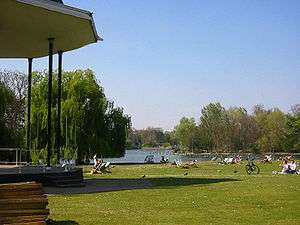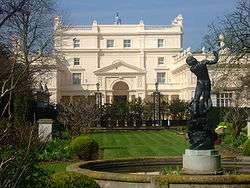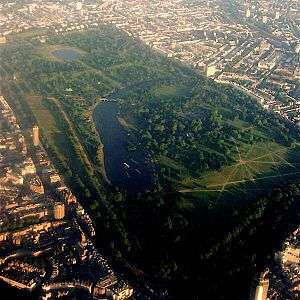Regent's Park
| Regent's Park | |
|---|---|
|
Regent's Park bandstand and lake | |
 Location within central London | |
| Type | Public park |
| Location | London, England |
| Coordinates | 51°31′56″N 0°09′24″W / 51.532222°N 0.156667°WCoordinates: 51°31′56″N 0°09′24″W / 51.532222°N 0.156667°W |
| Area | 410 acres (170 ha) (1.6 km²) |
| Status | Open year round |
| Website |
www |
Regent's Park (officially The Regent's Park) is one of the Royal Parks of London. It lies within north-west London, partly in the City of Westminster and partly in the London Borough of Camden.[1] The population of the Westminster ward at the 2011 Census was 13,528.[2] The population of the Camden Ward at the 2011 Census was 13,528.[3] It contains Regent's University London and the London Zoo.
The park is Grade I listed on the Register of Historic Parks and Gardens.[4]
Description
The park has an outer ring road called the Outer Circle (4.45 km) and an inner ring road called the Inner Circle (1 km), which surrounds the most carefully tended section of the park, Queen Mary's Gardens. Apart from two link roads between these two, the park is reserved for pedestrians. The south, east and most of the west side of the park are lined with elegant white stucco terraces of houses designed by John Nash and Decimus Burton. Running through the northern end of the park is Regent's Canal, which connects the Grand Union Canal to the former London docks.
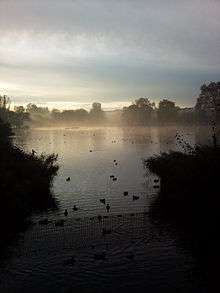
The 166 hectares (410 acres) park[5] is mainly open parkland that enjoys a wide range of facilities and amenities including gardens, a lake with a heronry, waterfowl and a boating area, sports pitches, and children's playgrounds. The northern side of the park is the home of London Zoo and the headquarters of the Zoological Society of London. There are several public gardens with flowers and specimen plants, including Queen Mary's Gardens in the Inner Circle, in which the Open Air Theatre is located; the formal Italian Gardens and adjacent informal English Gardens in the south-east corner of the park; and the gardens of St John's Lodge. Winfield House, the official residence of the U.S. Ambassador to the United Kingdom, stands in private grounds in the western section of the park. Nearby is the domed London Central Mosque, better known as Regent's Paron mosque, a highly visible landmark.
Located to the south of the Inner Circle is Regent's University London, home of the European Business School London, Regent's American College London (RACL) and Webster Graduate School among others.
On the northern side of Regent's Park is Primrose Hill, which with a height of 256 feet (78 m)[6] gives has a clear view of central London to the south-east, as well as Belsize Park and Hampstead to the north. Primrose Hill is also the name given to the surrounding district.
Management
The public areas of Regent's Park are managed by The Royal Parks, a government agency. The Crown Estate Paving Commission is responsible for managing certain aspects of the built environment of Regent's Park. The park lies within the boundaries of the City of Westminster and the London Borough of Camden, but those authorities have only peripheral input to the management of the park. The Crown Estate owns the freehold of Regent's Park.
History


In the Middle Ages the land was part of the manor of Tyburn, the property of Barking Abbey. In the Dissolution of the Monasteries, Henry VIII appropriated the land, and it has been Crown property ever since, except for the period between 1649 and 1660. It was set aside as a hunting park, known as Marylebone Park, until 1649. It was then let out in small holdings for hay and dairy produce.[7]
When the leases expired in 1811 the Prince Regent (later King George IV) commissioned architect John Nash to create a masterplan for the area. Nash originally envisaged a palace for the Prince and a number of grand detached villas for his friends, but when this was put into action from 1818 onwards, the palace and most of the villas were dropped. However, most of the proposed terraces of houses around the fringes of the park were built. Nash did not complete all the detailed designs himself; in some instances, completion was left in the hands of other architects such as the young Decimus Burton. The Regent Park scheme was integrated with other schemes built for the Prince Regent by Nash, including Regent Street and Carlton House Terrace in a grand sweep of town planning stretching from St. James's Park to Parliament Hill. The scheme is considered one of the first examples of a garden suburb, and continues to influence the design of suburbs.[8] The park was first opened to the general public in 1835, initially for two days a week. The 1831 diary of William Copeland Astbury describes in detail his daily walks in and around the park, with references to the Zoo, the canal, and surrounding streets, as well as features of daily life in the area.[9]
On 15 January 1867, forty people died when the ice cover on the boating lake collapsed and over 200 people plunged into the lake.[10] The lake was subsequently drained and its depth reduced to four feet before being reopened to the public.[11]
Late in 1916 the Home Postal Depot, Royal Engineers moved to a purpose built wooden building (200,000 sq ft) on Chester Road, Regent’s Park. This new facility contained the Home Postal Depot administration offices, a large parcel office and army letter office both of which moved from GPO Mount Pleasant. HM King George V and HM Queen Mary visited Home Postal Depot at Regent’s Park on 11 December 1916. The Depot vacated the premises in early 1920.[12]
Queen Mary's Gardens in the Inner Circle were created in the 1930s, bringing that part of the park into use by the general public for the first time. The site had originally been used as a plant nursery and had later been leased to the Royal Botanic Society.
In 1982 an IRA bomb was detonated at the bandstand, killing seven soldiers.
The sports pitches, which had been relaid with inadequate drainage after the Second World War, were relaid between 2002 and 2004, and in 2005 a new sports pavilion was constructed.
On 7 July 2006 the Park held an event for people to remember the events of the 7 July 2005 London bombings. Members of the public placed mosaic tiles on to seven purple petals. Later bereaved family members laid yellow tiles in the centre to finish the mosaic.
Sport
Sports are played in the park including Tennis, Netball, Athletics, Cricket, Softball, Rounders, Football, Hockey, Australian Rules Football, Rugby, Ultimate Frisbee and Running. Belsize Park Rugby Football Club play their home games in the park.
There are three playgrounds and there is boating on the lake.
Sports take place in an area called the Northern Parkland, and are centred on the Hub. This pavilion and underground changing rooms was designed by David Morley Architects and Price & Myers engineers, and opened by Queen Elizabeth II in 2005. It won the IStructE Award for Community or Residential Structures in 2006.
The Outer Circle is used by road cyclists - one circuit is 4.5 km.
The park was scheduled to play a role in the 2012 Summer Olympics, hosting the baseball and softball, but these sports were dropped from the Olympic programme with effect from 2012. The Olympic cycling road race was supposed to go through Regent's Park, as was the cycling road race in the 2012 Summer Paralympics, but the routes were changed.[13][14] The Park also plays host to London Camanachd who have regular shinty scrimmages there.
The terraces
John Nash was appointed architectural 'overseer' for the Regent's Park projects of Decimus Burton: Cornwall Terrace, York Terrace, Chester Terrace and the villas of the Inner Circle, including The Holme. However, to the chagrin of Nash, Decimus largely disregarded his advice and developed the Terraces according his own style, to the extent that Nash sought the demolition and complete rebuilding of Chester Terrace, but in vain. Decimus's terraces were built by his father, James Burton (property developer).[15][16]
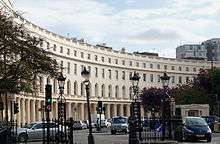
Clockwise from the north the terraces are:
- Gloucester Gate, a terrace of 11 houses designed by Nash and built by Richard Mott in 1827
- Cumberland Terrace, designed by Nash and built by William Mountford Nurse in 1826
- Chester Terrace, the longest façade in the park, designed by Nash and Decimus Burton and built by James Burton in 1825
- Cambridge Terrace, designed by Nash and built by Richard Mott in 1825. Cambridge Gate was added in 1876-80.
- York Terrace, designed by Nash and Decimus Burton the eastern half built by James Burton and the western half built by William Mountford Nurse
- Cornwall Terrace, consisting of 19 houses designed by Decimus Burton and built by James Burton
- Clarence Terrace, the smallest terrace, designed by Decimus Burton
- Sussex Place, originally 26 houses designed by Nash and built by William Smith in 1822-23, rebuilt in the 1960s behind the original façade to house the London Business School
- Hanover Terrace, designed by Nash in 1822 and built by John Mckell Aitkens
- Kent Terrace, behind Hanover Terrace and facing Park Road, designed by Nash and built by William Smith in 1827[7]
Immediately south of the park are Park Square and Park Crescent, also designed by Nash.
The villas

Nine villas were built in the park. There follows a list of their names as shown on Christopher and John Greenwood's map of London (second edition, 1830), with details of their subsequent fates:
Close to the western and northern edges of the park
- Marquess of Hertford's Villa: later known as St Dunstans; rebuilt as Winfield House in the 1930s and now the American Ambassador's residence. Largest private garden in London second to the Queen's garden at Buckingham Palace.
- Grove House: still a private residence but previously owned by Robert Holmes à Court, the Australian businessman. His estate sold the property after he died from a heart attack in the early 1990s. Grove House is said to have one of the largest gardens in central London after Buckingham Palace. The garden runs along the edge of Regent's Canal.
- Hanover Lodge: as of 2005 under restoration for renewed use as a private residence. Recently (2007) the subject of a Court Case (won by Westminster City Council against the architect, Quinlan Terry, and contractor, Walter Lilly & Co) that ruled that two Grade II listed buildings had been illegally demolished while the property was leased to Conservative peer, Lord Bagri. It has been falsely reported that the neo-classical roadside lodges no longer stand, when actually the roadside elevations are intact and are being restored with the remaining structures by Quinlan Terry
- Albany Cottage: demolished. Site now occupied by London Central Mosque.
- Holford House (not shown on Greenwood's map; but see Stanford's map of 1862): built in 1832 north of Hertford House, and the largest of the villas at that time. From 1856 it was occupied by Regent's Park College (which subsequently moved to Oxford in 1927). In 1944 Holford House was destroyed to a great extent when a bomb was dropped on it during World War II, and it was demolished in 1948.
Around the Inner Circle
- St John's Lodge: is the private residence of Prince Jefri Bolkiah of Brunei, but part of its garden is now a public garden designed by Colvin and Moggridge Landscape Architects in 1994. This is an arrangement with the Lodge's owners who have allowed the main portion of their garden to be enjoyed by the public.
- The Holme: once owned by Audrey Pleydell-Bouverie, the sister of the surrealist art collector Edward James, and still a private residence. The garden is open several days a year via the National Gardens Scheme.[17]
- South Villa: site of George Bishop's Observatory, closed when its owner died in 1861, with instruments and dome moved to Meadowbank, Twickenham in 1863. Regent's University London now stands on the site, one of the two largest groups of buildings in the park alongside London Zoo.
- Regent's University London has its campus just Southwest of the inner circle. Previously this campus was home to Bedford College.
Close to the eastern edge of the park
- Sir H. Taylor's Villa: demolished; site now part of the open parkland.
- International Students House, London
- A residential history of St John's Lodge, The Holme and Hanover Lodge is to be published by the owners in 2007 along with some aspects of the litigation history surrounding these properties, including the IRA bombing of the nearby bandstand on Holme Green.
- Between 1988 and 2004 six new villas were built by the Crown Estate and property developers at the north western edge of the park, between the Outer Circle and the Regent's Canal. They were designed by the English Neo-Classical architect Quinlan Terry, who designed each house in a different classical style, intended to be representative of the variety of classical architecture, naming them the Veneto Villa, Doric Villa, Corinthian Villa, Ionic Villa, Gothick Villa and the Regency Villa respectively.[18]
More attractions
- Park Crescent's breathtaking façades by John Nash have been preserved, although the interiors were rebuilt as offices in the 1960s.
- The Camden Green Fair is held in Regent's Park as part of an ongoing effort to encourage citizens of London to go Green.
- The fountain erected through the gift of Cowasji Jehangir Readymoney is on The Broadwalk between Chester Road and the Outer Circle.
Transport
Nearest Tube stations
Nearest railway stations
Cultural references
In film
- In 28 Weeks Later (2007), the surviving members of the American military escort Tammy and Andy to Regent's Park to get evacuated out of London.
- Regent's Park is the setting and closing scene for the black comedy film Withnail and I (1987).
In literature
- In Agatha Christie's short story "The Adventure of the Italian Nobleman", Hercule Poirot and Arthur Hastings travel in a taxicab to Regent's Park to investigate a murder that has taken place in "Regent's Court", a fictional block of modern flats nearby.
- In Agatha Christie's story, "A Secret Adverserary", Julius Hersheimmer proposes to Jane Finn while in Regent's Park, on their way home from a celebratory dinner for defeating the protagonist of the story, the infamous Mr. Brown.
- Tommy Beresford proposes to Prudence "Tuppence" Cowley while they are driving past Regent's Park in "A Secret Adverserary" by Agatha Christie.
- Rosamund Stacey, protagonist of Margaret Drabble's novel The Millstone (1965), lives in "a nice flat, on the fourth floor of a large block of an early twentieth-century building, and in very easy reach of Regent's Park".
- Ian Fleming's James Bond novels frequently mention the headquarters of MI6 as a "tall, grey building near Regent's Park."[19]
- In Charlie Higson's post-apocalyptic young adult horror novel The Enemy (2009), a group of children make a perilous trek through an overgrown St. Regent's Park, en route to Buckingham Palace, where they seek safe refuge, after a worldwide sickness has infected adults turning them into something akin to zombies. In the park, diseased monkeys from the nearby zoo attack the group, killing several children and wounding others.
- In Ruth Rendell's crime novel The Keys to the Street (1996), much of the action (and murders) take place in and around Regent's Park.
- In J.K. Rowling's first novel Harry Potter and the Philosopher's Stone (1997) and the eponymous film, Harry goes to the London Zoo for his cousin's birthday.
- In Dodie Smith's children's novel The Hundred and One Dalmatians (1956), the protagonist dalmatian dogs live near Regent's Park and are taken there for walks by their human family, the Dearlys. Regent's Park is also featured in the films based on Smith's book.
- The Regent's Park is the setting for several scenes in Virginia Woolf's novel, Mrs. Dalloway (1925).
In music
- In Madness' single "Johnny The Horse" (1999), the eponymous character ends his days in the park after taking "his battered bones and broken dreams to Regent's Park at sunset".
In video games
- The first level of the 2000 video game 102 Dalmatians: Puppies to the Rescue takes place in Regent's Park.
References
- ↑ Westminster Boundary (Map). City of Westminster. 2008. LA 100019597 2008. Retrieved 14 April 2009.
- ↑ "City of Westminster ward population 2011". Neighbourhood Statistics. Office for National Statistics. Retrieved 16 October 2016.
- ↑ "Camden Ward population 2011". Neighbourhood Statistics. Office for National Statistics. Retrieved 20 October 2016.
- ↑ Historic England, "Regents Park (1000246)", National Heritage List for England, retrieved 10 February 2016
- ↑ "The Regent's Park". The Royal Parks. Retrieved 4 August 2012.
- ↑ Mills, A., Dictionary of London Place Names, (2001)
- 1 2 Weinreb, B. and Hibbert, C. (ed) (1995) The London Encyclopedia Macmillan ISBN 0-333-57688-8
- ↑ Stern, Robert A.M.; Fishman, David; Tilove, Jacob (2013). Paradise Planned: The Garden Suburb and the Modern City. The Monacelli Press. p. 23. ISBN 1580933262.
- ↑ "William Copeland Astbury". Facebook. 15 April 2013. Retrieved 30 April 2013.
- ↑ The Catastrophe in the Regent's Park, The Times, 22 January 1867, p.12
- ↑ London, past and present: its history, associations, and traditions - Henry Benjamin Wheatley, Peter Cunningham - Google Books. Books.google.com. Retrieved 4 August 2012.
- ↑ Col ET Vallance (2015). 'Postmen at War – A history of the Army Postal Services from the Middle Ages to 1945' p.110, 114. Stuart Rossiter Trust, Hitchin.
- ↑ UCI wants London Olympic road race route changed, CyclingWeekly
- ↑ Exclusive: 2012 Olympics road race route, CyclingWeekly
- ↑ ODNB, Burton, Decimus (1880-1881)
- ↑ "James Burton [Haliburton]", Oxford Dictionary of National Biography".
- ↑ NGS website
- ↑ Kenneth Powell (25 November 2002). "Grandeur cannot be done cheaply". The Daily Telegraph. Retrieved 31 March 2014.
- ↑ Daniel Craig snaps up £4million apartment near Regent's Park 12-10-08
Bibliography
- Stourton, James (2012). Great Houses of London (Hardback). London: Frances Lincoln. ISBN 978-0-7112-3366-9.
- Weinreb, B. and Hibbert, C. (ed) (1995) The London Encyclopedia Macmillan ISBN 0-333-57688-8
- Wheatley, Henry Benjamin and Cunningham, Peter "London, Past and Present: Its History, Associations, and Traditions, Vol. III"
External links
| Wikiquote has quotations related to: Regent's Park |
- Official website
- Regent's Park in Literature and Music, a bibliography
- London, Past and Present: Its History, Associations, and Traditions
| Wikimedia Commons has media related to Regent's Park. |
